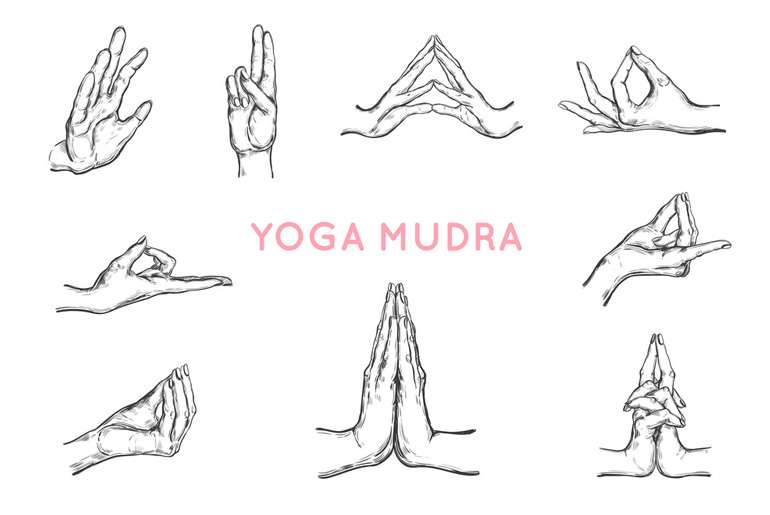Constipation is a common digestive issue characterized by infrequent bowel movements and difficulty passing stool. It can lead to discomfort, bloating, and abdominal pain. Several factors contribute to constipation, including a lack of dietary fiber, inadequate hydration, sedentary lifestyle, and certain medical conditions or medications.
Managing constipation typically involves lifestyle modifications such as increasing fiber intake, drinking more water, regular exercise, and establishing a consistent bowel routine. Over-the-counter laxatives may be used in the short term, but they should not be relied upon regularly without medical supervision. Chronic or severe constipation may require medical evaluation to identify underlying causes and develop appropriate treatment plans. Overall, a balanced diet, adequate hydration, and a healthy lifestyle are key factors in preventing and managing constipation.
Yoga mudras are hand gestures or positions used in yoga and meditation practices to enhance physical, mental, and spiritual well-being. These gestures are believed to influence the flow of energy within the body and promote various health benefits. There are several different mudras, each with its specific purpose and symbolism.
Some common yoga mudras include Apana Mudra, Vayu Mudra, Varun Mudra, Ganesha Mudra, and Prana Mudra. Apana Mudra is associated with elimination and detoxification, Vayu Mudra aims to reduce excess air in the body, Varun Mudra is connected to the water element and digestion, Ganesha Mudra helps with obstacles and challenges, and Prana Mudra is believed to activate abdominal energy.
Here are five simple yoga mudras that may be helpful:
1. Apana Mudra:
Apana Mudra is a yoga hand gesture or mudra believed to have several health benefits, primarily related to digestion and elimination. It is thought to help in regulating the Apana Vayu, which is the downward energy in the body responsible for processes like elimination of waste and toxins. Here’s how to perform Apana Mudra:
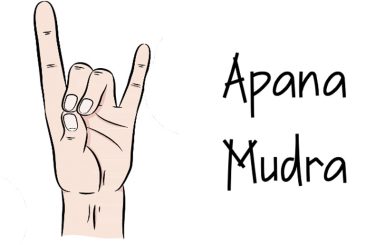
- Sit in a comfortable meditation or yoga pose. You can also do this while sitting in a chair with your feet flat on the ground.
- Relax your hands on your lap or knees, keeping your palms facing upward.
- Gently touch the tips of your thumb, middle finger, and ring finger together while keeping the other two fingers (index finger and little finger) extended.
- Maintain this hand gesture and hold it comfortably as you focus on your breath and your intention to support healthy digestion and elimination.
Apana Mudra is often practiced for about 15-30 minutes daily, either as part of a yoga or meditation session or independently. It is believed to help relieve constipation, bloating, and other digestive discomforts by promoting the smooth flow of energy in the abdomen and encouraging the elimination of waste products. While Apana Mudra can be a helpful addition to your wellness routine, it should not replace medical advice or treatment for chronic digestive issues.
2. Vayu Mudra:
Vayu Mudra is a yoga hand gesture or mudra that is thought to balance the air element in the body and alleviate issues related to excess air, such as gas, bloating, and flatulence. This mudra is believed to calm the Vayu or air energy within, helping to restore equilibrium. Here’s how to perform Vayu Mudra:
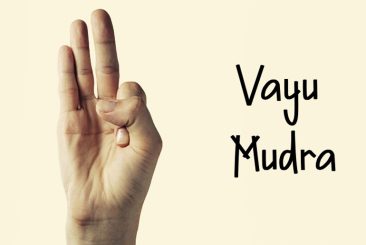
- Find a comfortable sitting position, either on the floor or in a chair.
- Keep your back straight and your hands resting on your knees or thighs.
- Begin by folding your index finger down and placing it at the base of your thumb.
- Lightly press your thumb over the folded index finger, creating gentle pressure.
- Keep your other three fingers (middle finger, ring finger, and little finger) extended and relaxed.
- Hold the Vayu Mudra comfortably while you breathe deeply and mindfully. Focus on your intention to reduce excess air in the body and promote digestive balance.
Practicing Vayu Mudra for about 15-30 minutes daily may help relieve symptoms of gas and bloating by harmonizing the air element within your body. It is important to remember that while yoga mudras like Vayu Mudra can complement your overall well-being, they should not be relied upon as the sole solution for medical conditions.
3. Varun Mudra:
Varun Mudra is a yoga hand gesture or mudra that is associated with the water element and is believed to have various health benefits, including improving digestion and promoting overall health. This mudra is often practiced to balance the water content in the body and address conditions related to dehydration or dryness. Here’s how to perform Varun Mudra:
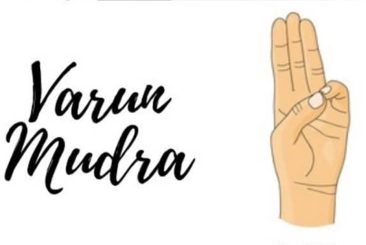
- Find a comfortable and relaxed sitting position, such as in a meditation posture or on a chair with your feet flat on the ground.
- Keep your back straight and your hands resting on your knees or thighs.
- To form Varun Mudra, touch the tip of your little finger (pinky finger) to the tip of your thumb, gently applying light pressure. Your other three fingers (index finger, middle finger, and ring finger) should remain extended and relaxed.
- Hold the Varun Mudra comfortably while you practice deep and mindful breathing.
- Focus on your intention to balance the water element in your body and promote healthy digestion and hydration.
Varun Mudra is typically practiced for about 15-30 minutes daily, and it is believed to help alleviate conditions related to dryness, such as dry skin, dry mouth, and digestive discomfort.
4. Ganesha Mudra:
Ganesha Mudra is a symbolic hand gesture in yoga that is associated with the Hindu deity Ganesha, the remover of obstacles and the god of beginnings. This mudra is believed to help overcome challenges, particularly those related to personal growth and self-improvement. Here’s how to perform Ganesha Mudra:
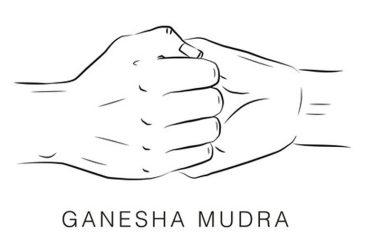
- Sit in a comfortable cross-legged position on the floor or in a chair with your feet flat on the ground.
- Extend your arms in front of you at shoulder level.
- Bend both elbows and bring your right hand in front of your chest, with the palm facing outward.
- Place your left hand behind your back, with the palm facing outward as well.
Try to interlock the fingers of your right and left hands. If you cannot fully interlock them, simply grasp your right wrist with your left hand.
- Once your hands are in position, gently pull them in opposite directions, creating a slight tension without straining.
- Keep your spine straight and your shoulders relaxed.
- Breathe deeply and mindfully as you hold the Ganesha Mudra for a few breaths or for as long as it feels comfortable.
During the practice of Ganesha Mudra, you can focus on your intention to overcome obstacles, whether they are physical, mental, or emotional. It’s a gesture of determination and inner strength. This mudra can be integrated into your yoga or meditation practice as a way to clear mental and emotional blockages and foster personal growth.
5. Prana Mudra:
Prana Mudra is a yoga hand gesture or mudra that is believed to activate and channel the vital life force energy, known as “prana,” within the body. This mudra is thought to increase vitality, improve overall health, and invigorate the body and mind. Here’s how to perform Prana Mudra:
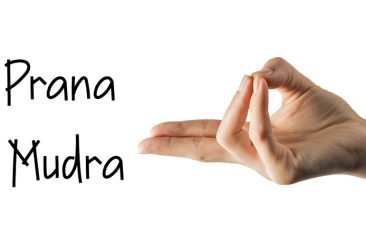
- Find a comfortable seated position, such as in a meditation posture or on a chair with your feet flat on the ground.
- Keep your back straight and your hands resting on your knees or thighs.
- To form Prana Mudra, gently touch the tip of your thumb to the tips of your ring finger and little finger while keeping the other two fingers (index finger and middle finger) extended and relaxed.
- Hold the Prana Mudra comfortably while you practice deep and mindful breathing.
- Focus on your intention to enhance your vital energy (prana) and promote overall health and well-being.
Prana Mudra is typically practiced for about 15-30 minutes daily. It is believed to help boost energy levels, alleviate fatigue, and rejuvenate the body and mind. While practicing this mudra, you can concentrate on your breath and visualize the inflow of vital energy, infusing your entire being with vitality.
While these mudras may offer some relief from constipation and promote digestive health, it’s essential to remember that a healthy lifestyle, including a balanced diet, regular exercise, and adequate hydration, plays a crucial role in preventing and managing constipation. If constipation persists or is severe, it’s advisable to consult a healthcare professional for proper diagnosis and treatment. Yoga mudras can complement other strategies but should not be relied upon as the sole solution.
Disclaimer:
The information contained in this article is for educational and informational purposes only and is not intended as a health advice. We would ask you to consult a qualified professional or medical expert to gain additional knowledge before you choose to consume any product or perform any exercise.

